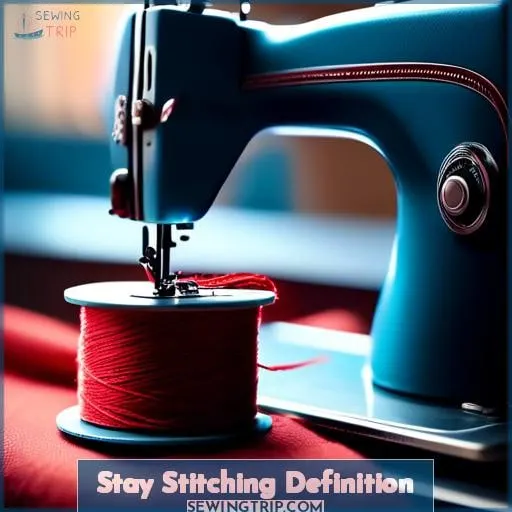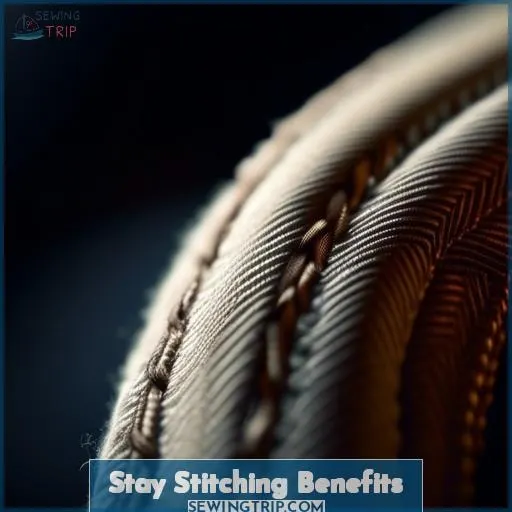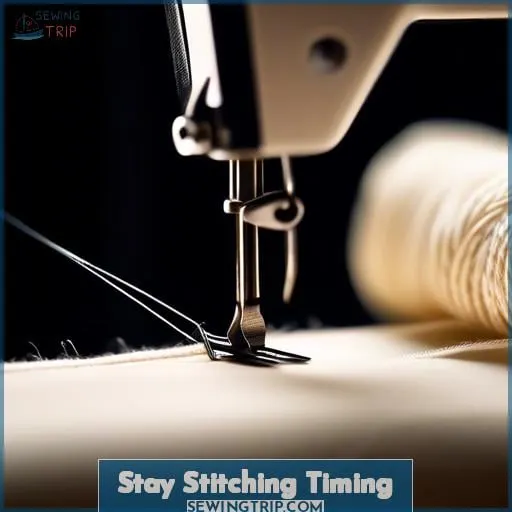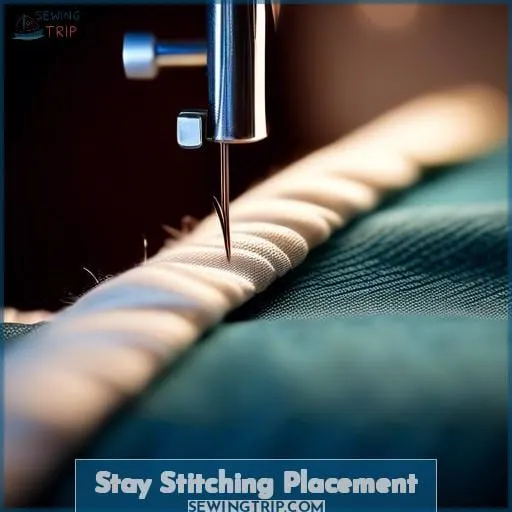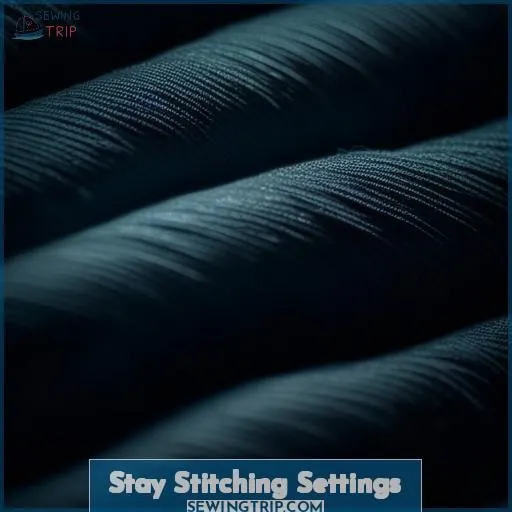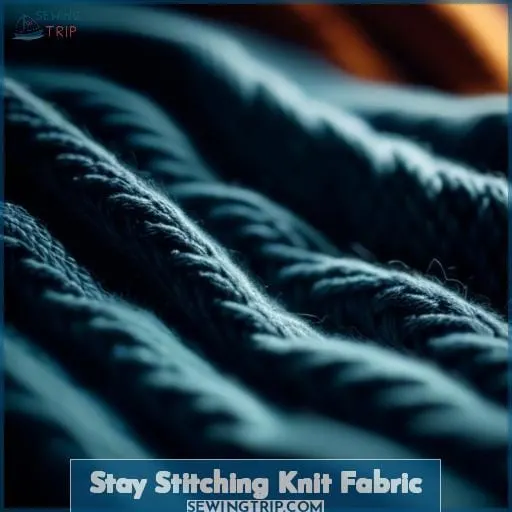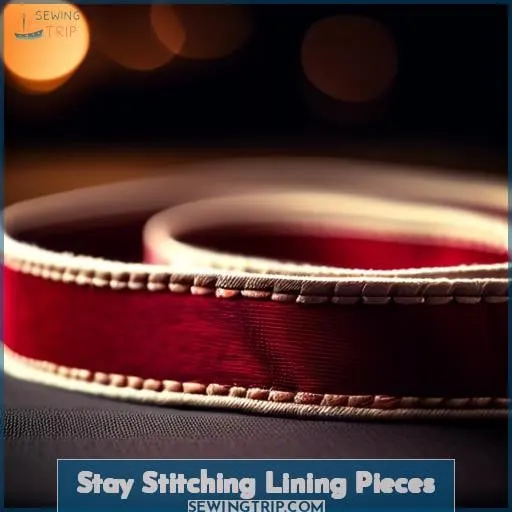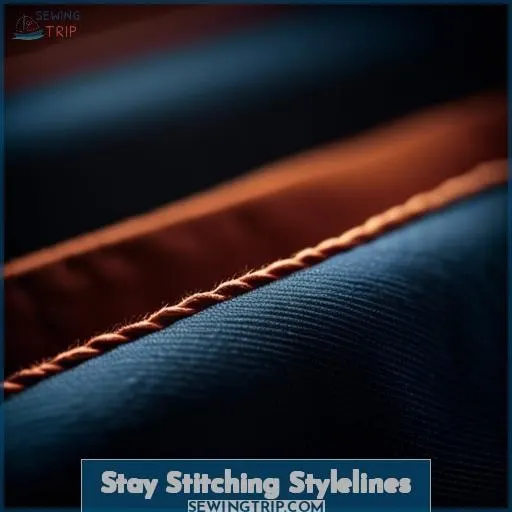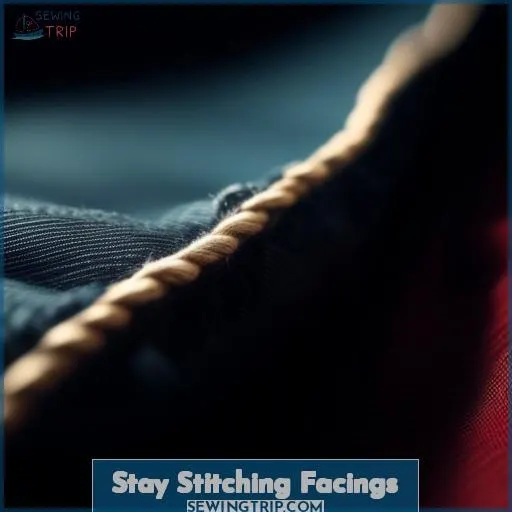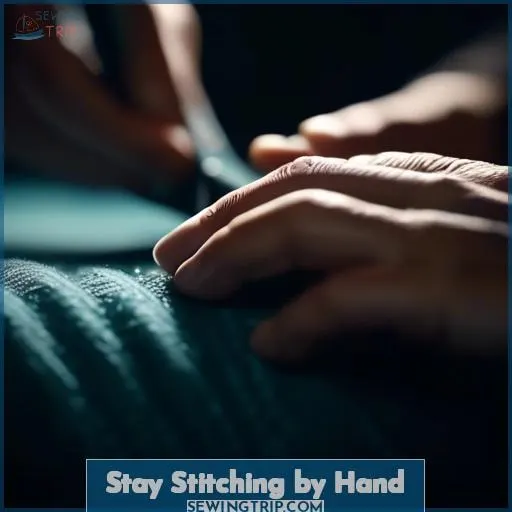This site is supported by our readers. We may earn a commission, at no cost to you, if you purchase through links.
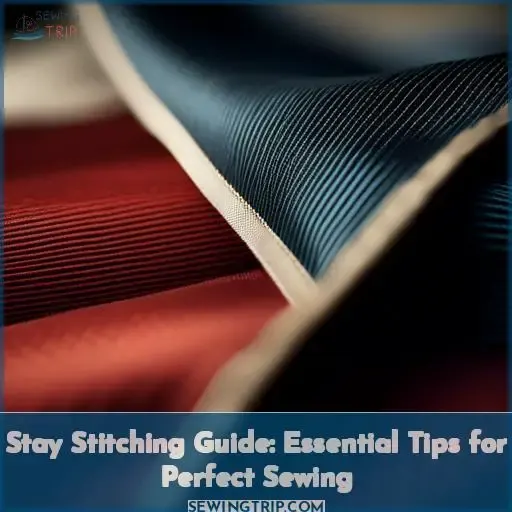 Like a skilled archer who knows the importance of a well-strung bow, you understand the power of preparation in crafting. Stay stitching is your secret weapon, ensuring your fabric holds its shape and integrity, much like the tension on a bowstring that leads to a perfect shot.
Like a skilled archer who knows the importance of a well-strung bow, you understand the power of preparation in crafting. Stay stitching is your secret weapon, ensuring your fabric holds its shape and integrity, much like the tension on a bowstring that leads to a perfect shot.
As you embark on your sewing journey, remember that this simple technique is the foundation of your quest for mastery over the materials at your fingertips. Let’s delve into the world of stay stitching, where each stitch is a step towards the ultimate goal of sewing perfection.
No, you do not need to backstitch when stay stitching because it is not a seam that requires strength. Stay stitching is designed to prevent fabric stretching and is kept in the garment, making backstitching unnecessary.
Table Of Contents
Key Takeaways
- Backstitching is not necessary when stay stitching, as these stitches are not meant to provide strength to a seam.
- Stay stitching should be done immediately after cutting the fabric to prevent distortion, especially along curves and bias-cut edges.
- The stay stitching line should be sewn from the shoulder to the center front or back, starting and finishing with either a backstitch or by shortening the stitch length, although backstitching is optional.
- Stay stitching is applied to single layers of fabric and is meant to remain in the garment, unlike basting stitches which are removed after final seams are sewn.
Stay Stitching Definition
Stay stitching is a technique used in sewing to prevent distortion and stretching of fabric, especially along curves and bias-cut edges. It involves sewing a line of stitches through a single layer of fabric, typically along areas like necklines, armholes, and any curved or diagonal seams.
The purpose of stay stitching is to stabilize these areas and maintain the shape of the garment during construction, ensuring that the fabric lays flat against the body and that pattern pieces match up correctly.
Stay stitching is different from basting in that it uses a shorter stitch length (around 2mm) and is meant to be left in the garment permanently, providing ongoing stability. Basting, on the other hand, uses a longer stitch length and is removed after the final seams are sewn.
When stay stitching, it’s important to sew from the shoulder to the center front or back, and to start and finish with a backstitch or by shortening the stitch length to secure the stitches. It’s recommended to stay stitch immediately after cutting the fabric and to apply it to all areas that cross the bias grain.
For knit fabrics, stay stitching is generally not recommended because knits don’t have a natural bias and are less prone to stretching out. However, for woven fabrics, especially those with loose weaves, stay stitching is crucial.
Additional tips for stay stitching include reinforcing deep V necklines with stay tape, stay stitching armholes from the front shoulder to the underarm point and then from the back shoulder to the back armhole point, and applying stay stitching to stylelines and princess seams if the weave is loose.
Stay stitching can be done by hand or machine, and it’s also advised to stay stitch lining pieces and facings for added stability.
Stay Stitching Benefits
Stay stitching offers several benefits crucial for achieving a professional finish in sewing projects.
It enhances fabric stability, ensuring that the material doesn’t stretch or distort during the sewing process, especially important for curved edges like necklines and armholes.
This technique also helps in maintaining the shape of curves, preventing them from becoming misshapen as you work.
Moreover, stay stitching can aid in reducing fraying issues, keeping the fabric’s integrity intact throughout the construction of the garment.
While it might seem like an extra step, incorporating stay stitching into your sewing routine can significantly improve the overall quality and durability of your projects.
Fabric Stability Enhancement
Enhance fabric stability with stay stitching; it’s crucial for maintaining the integrity of curved edges.
On bias fabric or open-weave materials, reinforcing stitches safeguard the raw edge.
Optimize with precise stitch length and directional stitching for unwavering results.
Prevents Fraying Issues
As you enhance fabric stability with stay stitching, you’re also tackling the pesky issue of fraying. This technique is particularly crucial for open-weave fabrics like cotton and linen, which are more susceptible to fraying.
- Locks in Shape: Stay stitching maintains the intended shape of your fabric along curves and corners, ensuring a crisp, professional finish.
- Strengthens Edges: It reinforces the fabric’s edge, especially at points of tension like V-necks or sharp corners.
- Secures Bias Cuts: By stabilizing areas cut on the bias, stay stitching prevents the fabric from stretching and distorting.
- Enhances Durability: Your seams and hems will withstand wear and tear better, as stay stitching acts as an internal support system.
Curves Shape Maintenance
To maintain the shape of your garment’s curves, stay stitching is crucial. It’s a simple straight stitch that prevents the fabric from stretching, especially along bias-cut edges like armholes and necklines.
| Ideal Stitch Length | Ideal Stitch Direction |
|---|---|
| 2mm or less | Shoulder to center |
| on each side |
For areas like deep V necklines or slashed necklines, reinforce with stay stitching and consider using stay tape for extra stability. Always stitch from the outer edge toward the center to avoid distortion. Stay stitching isn’t just about preventing stretching; it’s about mastering the art of sewing to create garments that fit perfectly and look professional.
Stay Stitching Timing
Understanding the intricacies of stay stitching is crucial for any sewing project that involves curves or bias cuts. Stay stitching is a straight stitch sewn through a single layer of fabric, primarily used to prevent distortion of curves during garment construction.
It’s a foundational technique that ensures the fabric maintains its intended shape throughout the sewing process.
Now, let’s delve into the timing of stay stitching, which is a pivotal aspect of this technique. The moment you cut your fabric is when it’s most vulnerable to stretching and losing its shape, especially along curves and bias-cut edges.
To safeguard against this, you should stay stitch as soon as possible after cutting.
- Stay stitching timing: It’s best to stay stitch immediately after cutting the fabric to prevent any distortion before sewing begins.
- Stay stitching accuracy: Precision is key. Stay stitching should be close to the seam line but within the seam allowance to ensure it doesn’t show on the finished garment.
- Stay stitching needle and thread: Use a needle and thread that are appropriate for the fabric type to avoid puckering or damage.
By adhering to these guidelines, you’ll maintain the integrity of your fabric’s shape, leading to a more professional-looking finished garment. Remember, stay stitching isn’t just a suggestion—it’s an essential step in garment construction that can make a significant difference in the final outcome.
Stay Stitching Placement
Once you’ve cut your fabric, it’s crucial to stay stitch those areas prone to stretching, such as necklines and armholes, to ensure they maintain their shape during the sewing process.
| Stay Stitching Placement | Details |
|---|---|
| Neckline | Begin at the shoulder, stitching down to the center front/back. |
| Armholes | Start at the front shoulder, sewing to the underarm point, then repeat from the back shoulder to the back armhole point. |
| Diagonal Seams | Stay stitch any diagonal seams to prevent distortion. |
| Shoulder Seam | If crossing the bias grain, stay stitch to stabilize. |
| Facings | Stay stitch facings to prevent stretching and fraying. |
For stay stitching curved areas, always sew from the edge to the center on each side to avoid distortion. When tackling v necks or other tricky points, reinforce with stay tape and additional stitches.
Whether you’re machine sewing or hand sewing, remember to use a straight stitch with a length of 2mm or less, and don’t stretch the fabric as you sew. Stay stitching placement isn’t just about preventing stretching; it’s about mastering the art of precision in garment construction.
Stay Stitching Settings
When setting up your machine for stay stitching, you’ll want to ensure precision and stability for the best results.
- Stay Stitch Length: Dial in a shorter stitch length, typically around 2.0 or less, to create a secure line of stitching that won’t need to be removed later.
- Stay Stitch Needle: Use a needle that’s appropriate for the fabric you’re working with. A universal needle often works well, but switch to a ballpoint for knits or a sharp for wovens if necessary.
- Stay Stitch Thread: Standard all-purpose thread is your go-to. It should match the weight and type of your fabric for consistent tension and strength.
- Stay Stitch Presser Foot: An all-purpose presser foot is usually sufficient, but for more delicate fabrics, consider a walking foot to prevent shifting.
- Stay Stitch Machine: Whether you’re using a basic home sewing machine or an industrial model, ensure it’s threaded correctly and the tension is adjusted for a smooth stitch.
Stay Stitching Knit Fabric
Moving from the general settings for stay stitching, let’s delve into the specifics of working with knit fabrics. Unlike woven materials, knit fabrics possess unique properties that often negate the need for stay stitching.
Their structure allows for natural stretch without the bias grain’s tendency to distort. However, when you’re aiming to add definition or prevent stretching in certain areas, stay stitching alternatives come into play.
Interfacing knit fabrics is a common technique to provide stability where needed. Machine settings for knit fabrics should be adjusted to accommodate their stretch, ensuring the fabric’s integrity isn’t compromised.
For those who prefer the control of hand sewing knit fabrics, careful stitches can also achieve the desired stability without hindering the fabric’s natural give.
When considering whether to backstitch when stay stitching, it’s typically not necessary for knits, as the goal is to maintain flexibility. And for those who embrace natural dye and eco-friendly practices, remember that the interfacing chosen should be compatible with the fabric’s characteristics.
Here’s a table summarizing the key points:
| Knit Fabric Properties | Stay Stitching Alternatives |
|---|---|
| Stretch without bias | Interfacing knit fabrics |
| Maintains shape | Machine settings for knits |
| Flexible integrity | Hand sewing for control |
By understanding these aspects, you can master the art of working with knit fabrics, ensuring your creations are both stable and free to express their inherent fluidity.
Stay Stitching Lining Pieces
When it comes to stay stitching lining pieces, it’s crucial to understand that this technique is just as important for linings as it’s for the main fabric.
-
Stay Stitch Bias Edges: Identify which parts of your lining are on the bias grain. These areas are prone to stretching and must be stay stitched to preserve the shape of your garment.
-
Stay Stitching Silk and Velvet: If your lining is made of silk or velvet, handle it with care. Stay stitching these delicate fabrics can prevent them from becoming misshapen during the sewing process.
-
Stay Stitching Jersey and Interfacing: For jersey linings, while stay stitching is typically not necessary due to the knit structure, it can be beneficial for interfacing areas to prevent stretching and distortion.
-
Technique: Use a straight stitch with a length of 2.0 or less, and sew from the edges toward the center on each side. This method ensures minimal movement of the fabric while sewing, keeping your lining crisp and well-shaped.
Stay Stitching Stylelines
When you’re crafting garments with stylelines, stay stitching is your secret weapon to maintain the integrity of the fabric’s shape. It’s particularly crucial for those areas not aligned with the straight grain, where the risk of stretching and distortion is higher.
Here’s a table to guide you through the key points of stay stitching various elements:
| Stay Stitching Element | Why It’s Important |
|---|---|
| Darts | Ensures the dart holds its shape, avoiding puckers or twists. |
| Pockets | Prevents the fabric around the pocket from sagging or distorting. |
| Plackets | Keeps the placket area flat and smooth for a professional finish. |
| Buttons | Stabilizes the area to prevent gaping and misalignment. |
| Zippers | Supports the fabric, ensuring the zipper lies flat and functions well. |
Stay Stitching Facings
After mastering the art of stay stitching stylelines to maintain the integrity of your garment’s shape, it’s time to turn your attention to facings.
These often-overlooked pieces are crucial for a clean finish around necklines and armholes. To ensure your facings lie flat and support the garment’s structure, stay stitching is your secret weapon. Apply this technique to the edges of your facings, just as you’d the main fabric pieces.
This not only secures the shape but also prevents the edges from stretching out of place.
When dealing with darts, pockets, pleats, ruffles, or zippers, stay stitching becomes even more essential. It acts as a safeguard, keeping these design details crisp and controlled throughout the construction process.
So, before you dive into sewing these elements, take a moment to stay stitch and set the stage for sewing success.
Stay Stitching by Hand
When it comes to stay stitching by hand, you’re engaging in a meticulous process that ensures the integrity of your fabric’s edges.
- Stay Stitching Tools: Equip yourself with a sharp needle and ensure your stay stitching thread matches the weight and type of your fabric.
- Stay Stitching Techniques: Use short, even stitches about 2mm in length, and be careful not to stretch the fabric as you sew.
- Stay Stitching Patterns: Follow the pattern’s grainline and curve, starting from the highest point to the lowest to prevent distortion.
Stay stitching by hand may take more time, but it’s a testament to your commitment to craftsmanship. Whether you’re reinforcing a delicate neckline or ensuring the perfect fit of a contoured waistline, your hand-sewn stay stitches are the silent guardians of your garment’s shape and structure.
Embrace this step as an opportunity to master your sewing skills and bring a touch of bespoke quality to your creations.
Frequently Asked Questions (FAQs)
Can stay stitching be used as a decorative element on garments?
While traditionally not designed for embellishment, stay stitching can indeed be creatively repurposed as a decorative element on garments.
By selecting contrasting threads or playing with stitch lengths and directions, you can add subtle, unique details that not only serve their functional purpose but also enhance the garment’s aesthetic appeal.
Is there a specific type of thread that should be used for stay stitching to ensure the best results?
For stay stitching, you’ll want to use a thread that matches the strength and weight of your fabric. All-purpose polyester thread is a great choice for its durability and flexibility.
It’s strong enough for most fabrics and projects, ensuring your stay stitching holds the fabric’s shape without breaking.
How does fabric choice affect the necessity and method of stay stitching?
Your fabric’s weave and stretch dictate your stay stitching approach.
Open weaves and bias cuts need it most to prevent distortion and maintain shape.
What are the consequences of not stay stitching on fabrics that are not open-weave?
Ironically, you might think skipping stay stitching is a shortcut to sewing success, but without it, you’re inviting a world of warping woes.
Even non-open-weave fabrics can betray you, stretching and distorting at the most inopportune moments, like a neckline that suddenly sags with the weight of a thousand regrets.
Stay stitching is your silent guardian, ensuring that every curve and corner remains true to form, empowering you to master the fabric’s willful nature.
Are there any alternative techniques to stay stitching for preventing fabric distortion during sewing?
Yes, there are alternative techniques to stay stitching for preventing fabric distortion during sewing.
You can use fusible interfacing or tapes like seam tape, which is fusible and can be ironed on around necklines, armholes, and hems to prevent stretching.
Another option is using lightweight fusible interfacing strips within the seam allowance or applying bias tape for heavier fabrics where stay stitching might cause distortion.
Conclusion
Embark on your sewing odyssey with the finesse of a Renaissance artisan, using stay stitching as your guide to precision.
This technique is your ally in crafting garments that boast impeccable shape and enduring elegance.
Now, with needle poised, let the fabric’s journey from flat to fabulous commence, under your skillful hands.

